The Berlin Series:
- Berlin Day 1: Travel & Copenhagen
- Berlin Day 2: Brandenburg Gate-Reichstag-Checkpoint Charlie
- Berlin Day 3: Food Tour, East Side Gallery, and the Hasselhoff “Museum”
- Berlin Day 4: Museum Island, River Cruise, and the Ice Bar
- Berlin Day 5: Trip to Barsinghausen
- Berlin Day 6: Tempelhof Airport and Adjusted Travel Plans
- Berlin Day 7: Bonus Day in Berlin and Travel Home
Berlin Day 2 (March 12, 2023)
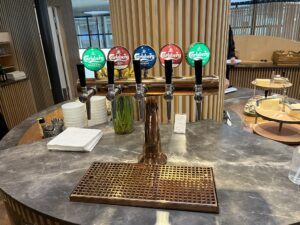
Airports are beyond time. We made full use of the 7:30 a.m. self-serve breakfast bar.
Amy set her alarm for 5:30 a.m. and we were set for an early start on Sunday morning (March 12 if you’re keeping score). Harper is usually our weakest link at such moments, but she’d slept in her clothes, hadn’t even opened her bag, and got out of bed reasonably easily. Having stayed at the Copenhagen airport Clarion, we were literally right next door. That was super convenient. No trams, no taxis, nothing. Just walk next door and into the terminal. (There was some construction underway or else we wouldn’t have even needed to go outside.) One of the perks of what we call our “fancy pants travel credit card” is lounge access in a lot of airports. The Carlsberg Aviator Lounge in Copenhagen is a good one. (I’d give it a backseat to the lounge in Lisbon, but that one is hard to beat.) Cole took full advantage of the 7:30 a.m. self-serve beer station. I didn’t entirely avoid it myself. Time is just a construct, particularly when you’re dealing with airports and time zones.
An incidental moment I enjoyed at the lounge was what I took to be a grandfather interacting with his grandchildren. Nothing special, I don’t suppose. Just a guy who seemed to be having a great time eating and goofing around with his little grandkids on a trip.
The flight to Berlin from Copenhagen was short and easy. Maybe an hour. A driver picked us up at the airport and, en route, pointed out the Tempelhof Airport. He’d seen a video about it. We were excited because that was on our list of places to go later in the week. We rested for a bit when we got to the Airbnb at Schliemannstraße 17 in Berlin. I’d gone my entire life not knowing what that “ß” meant. Turns out it’s an “eszett” more or less a double “s.” Handy to know, since they’re all over the place in Berlin! The Airbnb was a nice two bedroom set up on the fourth floor. Aside from the broken elevator, the only drawback was a single bathroom. We had no cause to complain since it was clear up front that’s what the place had available. But, it did present a bottleneck at various times during the vacation.
We settled on a Portuguese cafe on the block, Bekarei, as a good place for lunch. The sandwiches were good and, bonus points, they had Super Bock available. (In fact, I’d ordered a Sagres since that’s what they had on display. They only had Super Bock available, would that be “ok?” Of course! When we’d been in Portugal last year, we had settled into being a Super Bock family.)
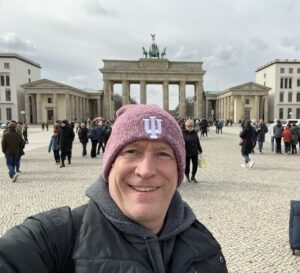
I, like John Wick and several others, have been to the Brandenburg Gate.
Our first “official” Berlin stop was the Brandenburg Gate. We had purchased the Berlin city card which included basically unlimited public transit for the week. Now we had to figure out how to use it. Google has made this sort of thing so much easier than it probably was in the past. Tell it where you want to go, and you’ll get appropriate combinations of tram, U-bahn, S-bahn, and what have you. The public transport is light years better than anything I’ve seen in the States. We were tourists going to touristy places, so that no doubt helps, but there was transport going everywhere we wanted to go. There wasn’t much waiting around. And everyone was using it. In the U.S., bus routes involve a lot of waiting, and it’s mostly just people who have no other options.
It was no problem at all to figure out the tram and the train that would get us to, if memory serves, our stop was the Unter de Linden station which was right next to the Brandenburg Gate. The Gate, like Berlin, has a complicated history. From connotations of peace to a triumphal symbol of conquest and victory to the site where East faced off against West during the Cold War to a place where an American family can now casually go for a stroll on a Sunday afternoon. It’s a cool looking structure, but often I don’t know what to do when I get to such places. Snap a few pictures, think about the people who had been there before you, and move on, I guess.
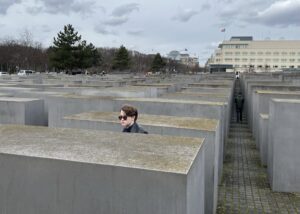
Memorial to the Murdered Jews of Europe
Nearby was the Memorial to the Murdered Jews of Europe which is an impressive installment. It is a large area covered with a grid of concrete slabs on sloping ground. I don’t know how to describe it, but it definitely got me into my head and in a reflective mood as I made my way among the taller slabs that envelope you among the undulating ground levels. As I made my way in no particular direction, I’d see my family members and other people at the site. Those encounters took me briefly out of the reflection before I was dropped right back in. The Reichstag is visible in the skyline above. One thing that impressed me in several parts of Berlin were plaques and whatnot that declared in no uncertain terms that Germany and the Nazis had been beaten and surrendered unconditionally and that they had committed atrocities such as murdering Jews and other groups. My sense was this is an effort to limit – as much as is ever possible – “Lost Cause” and “Stabbed in the Back” narratives from taking root. Failure to deal with “Lost Cause” narratives continues to plague the United States as Southern Whites were allowed to continue believing that their ancestors were engaged in something more defensible than Treason in Defense of Slavery; meanwhile, the “Stabbed in the Back” narrative obviously contributed to fascists taking power in Germany after World War I, pretending that they would have won the war if only Jews and other disfavored groups hadn’t been insufficiently patriotic.
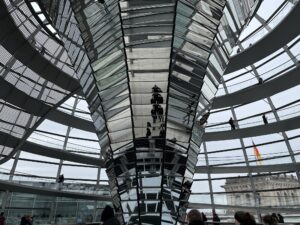
Inside the Reichstag Dome. We’re reflected in the mirror.
Next, Amy had made us reservations for a walk up the Reichstag Dome. The historical enormity of this structure is also hard to articulate. Arson at the site in the 1930s allowed the Nazis to take total control of the State. The War further destroyed the site. The Cold War made its reconstruction, let alone use as a German center of government, improbable. The Wall coming down, German reunification, re-location of government in Berlin, reconstruction of the Reichstag, and construction of the dome are a fairly profound symbol of rebirth. According to the Wikipedia page, “The futuristic and transparent design of the Reichstag dome is intended to symbolize Berlin’s attempt to move away from a past of Nazism and instead towards a future with a heavier emphasis on a united, democratic Germany.Specifically, it symbolizes that the people are above the government, as was not the case during Nazism.”
There was a lot to admire about the dome, but I was really taken by the mirror on the stem going up to the dome which reflected the people walking around the ramps very clearly. I don’t know what kind of wizardry is involved, but it’s impressive. Down at the base of the dome is a series of plaques that walk you through the history of the place.
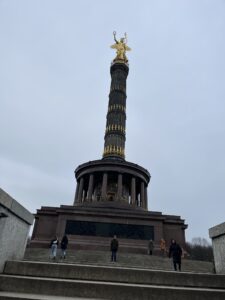
Fun Fact: Otto Von Bismarck has a monument nearby. “Hey! That fact wasn’t fun at all!”
After the Reichstag, we had a parting of the ways. Harper and Amy were interested in a coffee and a bit of a rest. Cole and I kind of wanted to walk the 1.25 miles or so to the Victory column. We did not make a bee line. Rather, we were distracted by the Soviet War Memorial and the Beethoven-Haydn-Mozart memorial in the Tiergarten. From a purely American perspective, the Soviet War Memorial is kind of bonkers. They’re the bad guys, right? Does nobody remember the documentary, Red Dawn? But it’s a testament to the complicated history of the place. For all of their own atrocities, the Soviet people were wronged by the Nazis. The Soviets controlled the area and erected a monument to the sacrifices and achievements of their people. Part of the German de-Nazification project involves recognizing that they were bad actors in WWII. And, so, you have Soviet tanks on the way to a Prussian monument.
The monument to the musicians is tucked away a little bit. We were walking the path and saw something shiny off to the side which turned out to be the Beethoven-Haydn-Mozart memorial. Cole joked about how their music seems to be the only “real” music in the eyes of the Jacobs School of Music where he’s currently studying. (Hyperbole, I’m sure.) It was apparently commissioned in 1904 by Kaiser Wilhelm, suffered a lot of damage during the War, and restored in 2007.
By and by, we made our way to the Victory Column. It’s an impressive structure in the middle of a traffic circle. I guess it has symbolized various things over the years, but Prussian military prowess and defeat of various European adversaries seems to be the main purpose. One cool feature is that it has tunnel access from the four corners of the intersection. Amy and Harper had taken a bus there but, with no obvious cross walks hadn’t figured out how to access the circle until Cole and I popped out of a tunnel. Once again, as a tourist, I’m never entirely sure what to do with these things. I look at it, admire the structure, snap a few pictures, and then go on to the next place. I’m not exactly speed running the sites, but I don’t know how deeply any of it is penetrating either. That said, if it’s an excuse to spend time with my family, it’s probably worthwhile.
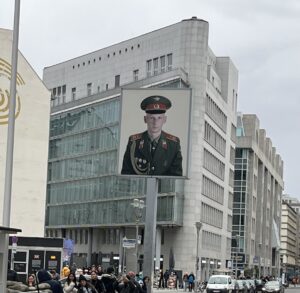
Checkpoint Charlie has this banner with Soviet and American soldiers opposite each other.
Next up, Checkpoint Charlie and its museum. The area itself is a street with a guard shack in the median and posters of American and Soviet soldiers hanging above. Back in the day, after East Germany put up the wall to keep its citizens in, this crossing point at the border was a symbol of the Cold War. Now it’s a street where I almost got hit because I was looking at the poster rather than watching out for traffic. There would have been some irony in getting hit by a car at that spot in the world. We went into the adjacent museum, and it is *dense*. This does not seem to be the work of professional historians. It’s informative, but a bit random. And there’s no real narrative that I could discern. But Ronald Reagan’s hat was there! Our family had mixed opinions on the museum. I think the kids ended up liking it better than the adults. Nerds!
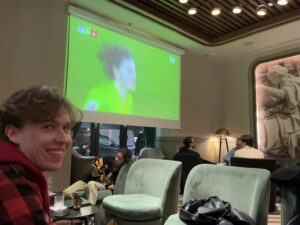
Enjoying a nightcap with comfy seats, soccer on the television, and complementary use of the facilities.
We had a well earned dinner at a place called Maximilians. It was good but not great. I had some trout, and Cole and I both had large beers. One thing about being an older man and a beer drinker is that one is well-advised to take advantage of a bathroom when the opportunity presents itself. Cole skipped that opportunity and quickly came to regret it as we made our way home. It was going to involve some time and train rides. The boy was in pain, and Berlin doesn’t have the number of public restrooms you might expect in a city so large. Eventually, we made the decision to stop in a restaurant and get more drinks so that we could be paying customers, entitled to use their facilities. I’m not sure if it was the Titanic hotel or the Pascarella restaurant where we landed, but there is a really comfy bar in between where we set up shop. It has nice seats, tables, and couches. Soccer was playing.. It was really a happy bit of spontaneity. (Amy had us so well planned that we joked about putting spontaneity on the schedule.)
At that point, we’d run ourselves pretty hard, and it was time for bed. I woke up in the middle of the night freezing. At the time, I thought it was just cold in the room. But in retrospect, it may have been a bit of a fever I didn’t know I had. Whatever it might have been was gone by morning.
Next time: food tour, East Wall, and the Hasselhoff “Museum”
Leave a Reply